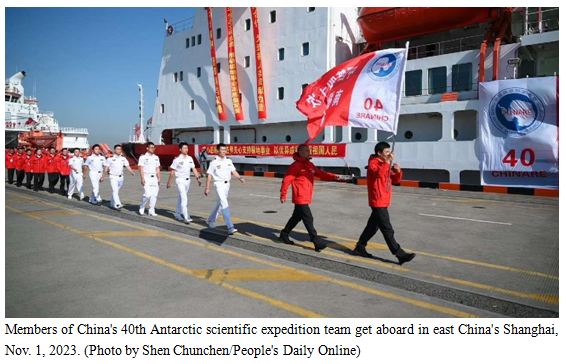By Liu Shiyao, Hu Runxin, People’s Daily
China’s 40th Antarctic scientific expedition team, organized by the country’s Ministry of Natural Resources (MNR), set sail from Shanghai on Nov. 1, embarking on a mission that is expected to last more than five months.
The expedition team will build a new scientific research station along the coastal areas of the Ross Sea, which will be the biggest highlight of the expedition. Upon completion, the new station will become China’s third perennial research station after the Changcheng and Zhongshan stations and the first research station dedicated to the Pacific sector. It will also be the country’s fifth research station in Antarctica.
The Ross Sea is the most southward-extending sea among all marginal seas of Antarctica. The top of the bay is located at about 78 degrees south latitude, which is very close to the South Pole.
The unique geographical location of the Ross Sea brings differentiated scientific research value, making it a beneficial complement to China’s Antarctic scientific research layout deserving greater investment for comprehensive scientific observation.
The construction of the new research station is of great significance.
Carrying out surveys, observation and monitoring of marine ecology, sea ice, glaciers, sea level, atmosphere, geophysics, high-altitude atmospheric physics, terrestrial ecology, terrestrial and marine geology, birds and more in this region will provide fundamental support for assessing the Antarctic ecological environment and climate change.
“The Ross Sea region has a strong appeal to scientists because it is like an ‘ice factory.’ It is an important generator of sea ice in the entire Southern Ocean, and a key origin of Antarctic bottom water,” said Sun Bo with the Polar Research Institute of China under the MNR.
The region features multi-circle interactions of the Earth system, including the geosphere, cryosphere, biosphere and atmosphere, which will help researchers explore important scientific issues such as Antarctic changes and global linkages, according to Sun.
The construction of the new station also reflects China’s active efforts to fulfill its responsibilities and obligations under the Antarctic Treaty system.
According to Long Wei, deputy director of Chinese Arctic and Antarctic Administration, a subsidiary of the MNR, China will cooperate with relevant countries in managing the Antarctic Specially Protected Area at Inexpressible Island and conduct ecological monitoring of the Ross Sea region Marine Protected Area, contributing to the protection of the Antarctic ecological environment and supporting China’s participation in Antarctic international governance.
Relying on the new station, China will carry out international cooperation on scientific expeditions and logistical support in Antarctica with neighboring research stations of other countries, striving to make new and greater contributions to the peaceful use of Antarctica by mankind, Long said.
With a building area of 5,244 square meters, the new Chinese Antarctic research station is expected to accommodate 80 expedition team members during summers and 30 members during winters after completion. It is planned to be used for atmospheric, oceanic, glacial, biological and other multidisciplinary observation, monitoring and scientific research.
The philosophy of “green expedition” will run through the entire construction process of the new research station.
While ensuring quality, safety and other basic requirements of the station, relevant personnel will make overall plans and adopt integrated designs for various systems of the station, in a bid to conserve resources and minimize environmental impact during the construction of the new research station.
Customized prefabrication and pre-assembly at home, as well as intensive management of construction materials, will also help the expedition team save energy, water, materials and other resources and protect the environment.
By reducing the disturbed area in Antarctica, cutting the number of temporary facilities and construction personnel, and maximizing control over the scope of construction activities, the expedition team will try to achieve the goal of green and eco-friendly construction.
In addition to the construction of the new station, the expedition team will also investigate the impacts of climate change on the Antarctic ecosystems and relevant consequences, while thoroughly studying the role of Antarctica in global climate change, according to Zhang Beichen, leader and chief scientist of China’s 40th Antarctic expedition.
Collaborative research in the frontiers of international Antarctic science will also represent an important part of this expedition.
During the expedition, Chinese scientists will carry out collaborative aerial surveys of the Enderby Land with their counterparts from countries including Norway and Australia, and explore the ice-ocean-bedrock interactions in the grounding zone of the Antarctic ice sheet, a key data gap region. They will also provide support for accurate assessments of ice sheet mass balance and instability research, and conduct international cooperation on logistical support with scientists from multiple countries.


















